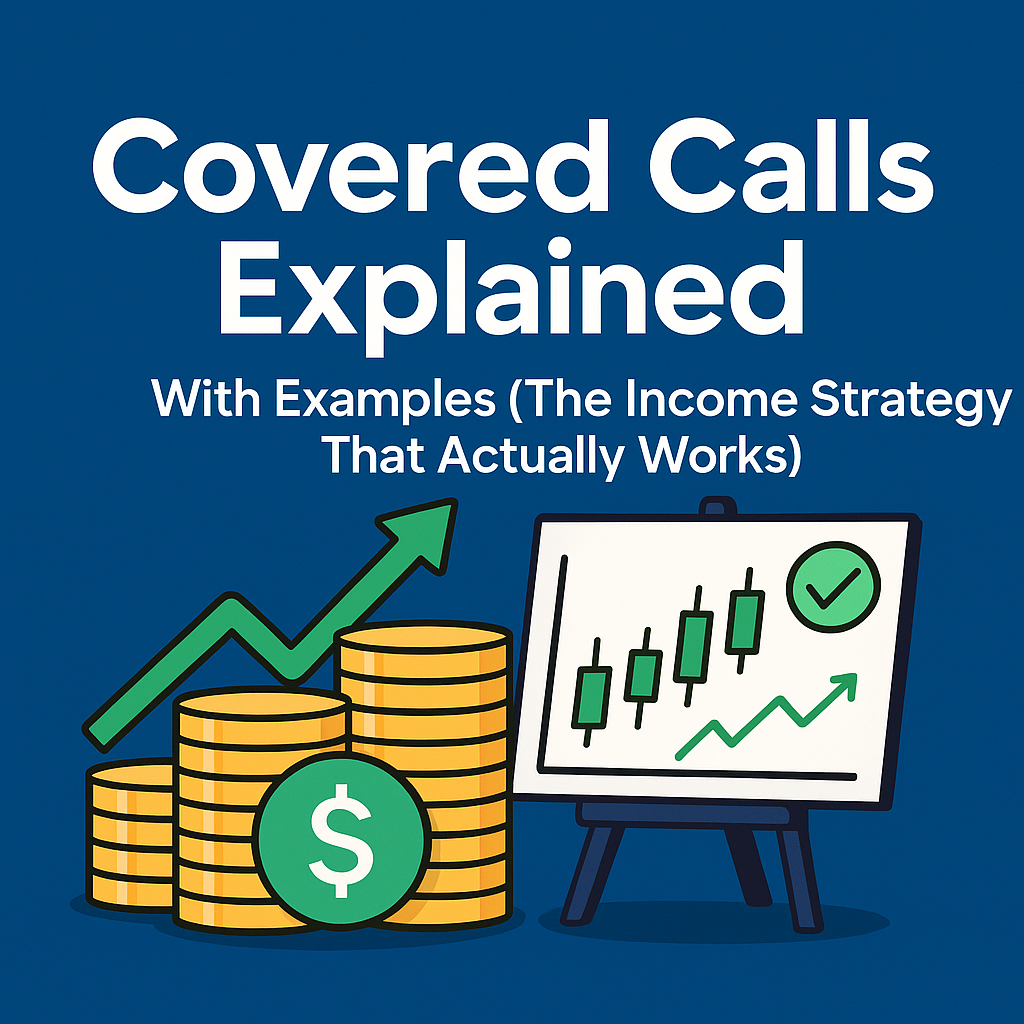Okay, let me tell you about the strategy that completely changed my investing game – covered calls. This is the strategy that turned my boring dividend portfolio into a cash-flowing machine that pays me $3,000-5,000 every single month. And before you ask, no, this isn’t some get-rich-quick BS. This is a legitimate strategy that’s been around forever, but for some reason, 90% of investors have no idea it exists.
I discovered covered calls by accident in 2019. I owned 500 shares of AT&T (yeah, I know, boomer stock) that I’d been bagholding since $35. The dividend was nice, but I was underwater and frustrated. Then a friend mentioned selling calls against my shares. “You mean I can get paid just for owning this crap?” I asked. Three years later, I’ve collected over $40,000 in call premiums on stocks I was planning to hold anyway.
Here’s the beautiful simplicity of covered calls: you own 100 shares of a stock, you sell someone the right to buy those shares from you at a higher price, and they pay you cash upfront for that right. If the stock doesn’t reach that price, you keep the cash and your shares. Rinse and repeat every month. It’s like being a landlord, but instead of renting out property, you’re renting out your stocks.
But here’s what kills me – financial advisors never mention this strategy. They’ll put you in some garbage mutual fund charging 2% fees, but they won’t teach you how to generate 1-3% monthly income from stocks you already own. Why? Because they can’t charge you fees on something you do yourself. Well, I’m about to show you exactly how to do it, with real examples and real numbers.
What Covered Calls Really Are (No Finance Degree Required)
Let’s break this down in plain English. A covered call is when you:

- Own 100 shares of a stock (the “covered” part)
- Sell a call option on those shares (the “call” part)
- Collect premium (cash) immediately
That’s it. You’re not doing anything fancy or risky. You’re just selling someone the opportunity to buy your shares at a predetermined price.
Think of it like this: imagine you own a house worth $500,000. Someone comes to you and says, “I’ll pay you $5,000 right now for the option to buy your house for $550,000 anytime in the next month.” You take the $5,000. If house prices skyrocket and they exercise the option, you sell for $550,000 (still a $50,000 profit plus the $5,000 premium). If prices stay flat, you keep the $5,000 and your house. That’s exactly what a covered call is, but with stocks.
The “worst” thing that can happen? Your stock gets called away at a profit. Oh no, you made money! The horror! I’ve had people tell me they’re afraid of covered calls because they might have to sell their shares. Buddy, if you’re so in love with a stock that you can’t bear to sell it for a profit, you shouldn’t be investing – you should be seeing a therapist about attachment issues.
My First Covered Call Trade (And Why I Was an Idiot)
Let me walk you through my very first covered call so you can learn from my mistakes. January 2019, I owned 100 shares of Ford at $9.50 (cost basis). Ford was trading at $8.80, so I was down $70. Depressing.
I decided to sell my first covered call:
- Sold the February $9 call for $0.15
- Collected $15 (yeah, fifteen whole dollars)
- Thought I was Warren Buffett
Ford stayed below $9, the option expired worthless, and I kept my $15. Not exactly yacht money, but I was hooked. The next month, I sold the $9 call again for $0.18. Then again for $0.20. After six months, I’d collected $108 in premiums, turning my $70 loss into a $38 gain without the stock moving.
But here’s where I was an idiot – I was selling calls way too close to the current price for peanuts. I was so afraid of having my shares called away that I was leaving money on the table. Once I learned to properly select strikes and manage positions, my monthly income went from $15 to $1,500+.
The Math That Will Make You Rich (Or At Least Richer)
Let’s do some real math with a real example. Say you buy 100 shares of Apple at $180. That’s an $18,000 investment. Here’s how covered calls transform this position:
Without Covered Calls:
- You own 100 shares at $180
- Apple pays $0.96/year in dividends = $96/year
- Annual return from dividends: 0.53%
- You wait and hope the stock goes up
With Covered Calls:
- You own 100 shares at $180
- Sell monthly $185 calls for $3.00 average ($300/month)
- Annual premium income: $3,600
- Plus dividends: $96
- Total annual income: $3,696
- Return on investment: 20.5%
That’s not a typo. You’re making 20% annually on Apple, not from the stock going up, but just from selling calls against shares you already own. And if Apple does go above $185 and your shares get called? You made $500 in capital gains plus all the premium you collected. Terrible problem to have.
The Five Types of Covered Call Strategies (And When to Use Each)
1. The Monthly Income Machine
This is my bread and butter strategy. Every month, I sell 30-45 day calls at 5-10% above the current price.
Example: Own 100 shares of Microsoft at $380
- Sell the $400 call expiring in 35 days for $4.00
- Collect $400
- If MSFT stays below $400, keep shares and $400
- Rinse and repeat next month
I run this on 10-15 positions, generating $3,000-5,000 monthly. It’s boring, predictable, and I love it.
2. The Earnings Play
Implied volatility spikes before earnings, making options expensive. I sell calls right before earnings to capture that extra premium.
Example: Disney earnings coming up, stock at $100
- Normal monthly call premium: $1.50
- Pre-earnings premium: $3.00
- Sell the $105 call for $3.00
- Even if Disney pops to $104, you keep everything
Warning: This can backfire if the stock moons. I once sold Netflix calls before earnings for $5. Stock jumped 15%. Still made money, but missed out on thousands in gains. Now I only do this on stocks I’m okay selling.
3. The Recovery Strategy
This is for underwater positions. You’re bagholding a stock, so you sell calls at your breakeven point to generate income while waiting for recovery.
Example: Bought Intel at $50, now it’s at $45
- Sell $50 calls for $0.50 every month
- After 10 months, collected $5 in premiums
- Effective cost basis now $45
- If stock recovers to $50, you break even plus all premiums
This strategy turned my biggest losers into winners. That AT&T position I mentioned? Sold calls for two years while underwater, finally got called away at breakeven, but kept $2,400 in premiums.
4. The Aggressive Income Strategy
For stocks you don’t mind losing, sell calls very close to the current price for maximum premium.
Example: Own 100 shares of Ford at $11
- Stock trading at $11.50
- Sell $11.50 calls for $0.40 (3.5% return in one month!)
- High probability of assignment, but who cares?
I do this with stocks I’m not married to. If they get called, great. If not, that’s a fat premium for a crap stock.
5. The Buy-Write
This is when you buy shares and immediately sell calls, reducing your cost basis from day one.
Example: Want to own Tesla but think it’s overpriced
- Buy 100 shares at $800
- Immediately sell $850 call for $30
- Effective purchase price: $770
- If called away at $850, you make $80 per share
- If not, you own Tesla $30 cheaper than market price
I use this when entering new positions. It’s like getting a discount on stocks you want to own.
Strike Selection: The Art and Science of Not Screwing This Up
Picking the right strike price is everything. Too close, and you’re giving away your shares for peanuts. Too far, and you’re collecting meaningless premiums. Here’s my system:
The Delta Method
I generally sell calls with a delta between 0.20 and 0.30. This means there’s a 20-30% chance of assignment. It’s the sweet spot between premium and probability.
Example: SPY at $480
- $485 call has 0.25 delta, premium $2.50
- $490 call has 0.15 delta, premium $1.50
- $482 call has 0.40 delta, premium $4.00
I’d sell the $485 call. Good premium, reasonable safety.
The Technical Analysis Method
I look at the chart and sell calls just above resistance levels.
Example: Apple bouncing between $175-185 for months
- Stock currently at $178
- Major resistance at $185
- Sell $186 calls
- Even if it breaks resistance, you’re selling at the top of the range
This method has saved me from assignment countless times. Resistance levels are real, and stocks respect them more often than not.
The Percentage Method
Simple but effective: sell calls 5-7% above current price for monthly expiration.
Example: Stock at $100
- Sell $105-107 calls
- Consistent 1-2% monthly returns
- Low assignment risk
- Boring but profitable
This is perfect for beginners. No complex analysis, just mechanical execution.
Managing Covered Calls Like a Pro (Not Like I Did Initially)
When to Roll
Your stock is approaching your strike price with time left. Don’t panic. You can “roll” the option.
Example: Sold Microsoft $400 calls, stock now at $398 with 5 days left
- Buy back the $400 call for $3.00
- Sell the $405 call next month for $5.00
- Net credit: $2.00
- Moved strike up $5 and collected more premium
I roll probably 30% of my positions. It’s normal and part of the strategy.
When to Let Them Get Called
Sometimes, just let it happen. If a stock rockets up 20%, let it go. Take your profit and find another opportunity.
True story: I sold Tesla $700 calls when it was at $650. Tesla ran to $900. I tried rolling, adjusting, everything to keep my shares. Finally let them go at $700. You know what? I still made $5,000 profit plus premiums. A week later, Tesla crashed to $600. Sometimes getting called away is a blessing.
When to Buy Back Early
If you’ve captured 80% of the premium with lots of time left, buy it back and sell another one.
Example: Sold 30-day call for $2.00
- After 10 days, can buy back for $0.40
- Captured 80% of profit in 33% of time
- Sell another call for next month
- Double dipping on premium
This accelerates income generation. Why wait for the last $0.40 when you can make another $2.00?
My Actual Covered Call Portfolio (Real Numbers)
Here’s my current covered call portfolio so you can see this isn’t theoretical:
Apple (AAPL) – 200 shares at $165 cost basis
- Current price: $180
- Selling $185 calls monthly
- Premium collected: $600/month
- Annual return on cost: 21.8%
Microsoft (MSFT) – 100 shares at $340 cost basis
- Current price: $380
- Selling $390 calls monthly
- Premium collected: $400/month
- Annual return on cost: 14.1%
SPY – 300 shares at $450 cost basis
- Current price: $480
- Selling $485 calls weekly (more aggressive)
- Premium collected: $900/month
- Annual return on cost: 24%
Ford (F) – 1000 shares at $10 cost basis
- Current price: $11.50
- Selling $12 calls monthly
- Premium collected: $300/month
- Annual return on cost: 36%
AT&T (T) – 500 shares at $28 cost basis
- Current price: $16 (yeah, it hurts)
- Selling $17 calls monthly
- Premium collected: $150/month
- Using premium to average down
Total monthly income from covered calls: $2,350
Annual income: $28,200
Portfolio value: ~$200,000
Yield from covered calls alone: 14.1%
This doesn’t include dividends or capital appreciation. Just pure option premium income.
The Risks Nobody Talks About (And How to Handle Them)
Risk 1: Missing Out on Huge Gains
Your stock rockets up 50%, but you sold calls at 10% above your purchase price. This is the main “risk” of covered calls – capped upside.
How I handle it: I never sell calls on more than 75% of my position in growth stocks. Keep some shares uncovered to capture those moon shots. On boring dividend stocks? Cover them all.
Risk 2: Stock Crashes While You’re Holding Calls
The stock tanks 30%, and that $2 premium you collected doesn’t help much.
How I handle it: Covered calls don’t protect against major downside. If you’re worried about a crash, buy protective puts or just sell the stock. Don’t use covered calls as insurance – they’re income generators, not protection.
Risk 3: Assignment and Taxes
Getting assigned can create taxable events. If you’ve held shares less than a year, it’s short-term capital gains.
How I handle it: Track your holding periods. On positions held less than a year, I sell calls further out or roll more aggressively to avoid assignment. After a year, I don’t care – long-term capital gains are fine.
Risk 4: Dividend Risk
If your call is in-the-money near ex-dividend date, you might get assigned early and miss the dividend.
How I handle it: Watch ex-dividend dates. If my call is ITM, I’ll often roll it before ex-dividend or buy it back if the dividend is significant.
Advanced Covered Call Tactics That Print Money
The Weekly Income Machine
Instead of monthly calls, sell weekly calls on high-volume stocks or ETFs.
Example with SPY:
- Monday: Sell Friday expiration $5 OTM for $0.50
- Friday: Expires worthless
- Following Monday: Repeat
- Monthly income: $200 per 100 shares
- Annual return: ~20% just from weeklies
More management required, but the income is addictive. I run weeklies on SPY, QQQ, and sometimes Tesla when I’m feeling spicy.
The Ratio Write
Own 500 shares? Sell 3 calls instead of 5, keeping 200 shares uncovered for upside.
Example: 500 shares of Apple at $180
- Sell 3 calls at $185 for $3 each = $900
- If stock rises to $190:
- 300 shares called away at $185 = $1,500 profit
- 200 shares now worth $190 = $2,000 unrealized gain
- Plus $900 premium
- Total profit: $4,400 vs $2,500 if fully covered
This balances income with upside potential. Perfect for stocks you’re bullish on but want income from.
The Diagonal Spread Enhancement
Buy a long-term call (LEAP) and sell monthly calls against it. It’s like covered calls but requires less capital.
Example: Instead of buying 100 shares of Amazon at $3,500 ($350,000!)
- Buy January 2026 $3,500 call for $400
- Sell monthly $3,600 calls for $30
- Monthly return: 7.5% on $4,000 investment
- Same strategy, 1/87th of the capital required
This is called a “Poor Man’s Covered Call” and it’s perfect for expensive stocks.
Common Covered Call Mistakes That Cost Me Thousands
Mistake 1: Selling Calls on Stocks You Love
I sold Tesla calls at $400 pre-split (now equivalent to $80). Stock ran to $900. I missed out on $50,000 in gains for $500 in premium. Never sell calls on stocks you’d be devastated to lose.
Mistake 2: Chasing Premium on Garbage Stocks
Bought some biotech trash because the call premiums were 10% monthly. Stock went to zero. High premium usually means high risk. Stick to quality companies.
Mistake 3: Not Tracking Your Basis
After selling calls for months, I forgot my adjusted cost basis and made poor decisions. Keep a spreadsheet tracking:
- Original purchase price
- Total premiums collected
- Adjusted breakeven
- Current market price
Mistake 4: Panic Rolling
Stock jumps, and you roll up and out repeatedly, paying more each time. Sometimes it’s better to just let shares go and find a new opportunity.
Mistake 5: Ignoring Earnings
Sold Disney calls day before earnings once. Stock jumped 15% on Disney+ announcement. Collected $100 in premium, missed $1,500 in gains. Now I check earnings dates religiously.
Your 90-Day Covered Call Action Plan
Days 1-30: Learn and Paper Trade
- Understand options basics
- Paper trade 5 covered call positions
- Track what would have happened
- Join r/thetagang on Reddit (actually useful)
Days 31-60: Start Small
- Pick one stock you own 100 shares of
- Sell your first real covered call 5-7% OTM
- Experience the full cycle
- Document everything
Days 61-90: Scale Up
- Add 2-3 more covered call positions
- Try different strategies (weekly vs monthly)
- Develop your own rules
- Start tracking monthly income
After 90 days, you’ll be generating consistent monthly income. Maybe $200, maybe $2,000, but it’ll be recurring and predictable.
The Tools That Make This Easy
Brokerage Platform
Any major broker works, but some are better:
- TastyWorks: Built for options traders
- TD Ameritrade: Great analysis tools
- Fidelity: Good for beginners
- Robinhood: Fine for basic covered calls
Options Screeners
- Market Chameleon: Shows highest premium opportunities
- Barchart: Good for finding covered call ideas
- Your broker’s scanner: Usually has covered call screeners
Tracking Spreadsheet
Create a simple spreadsheet with:
- Stock symbol and shares owned
- Strike sold and expiration
- Premium collected
- Current stock price
- Profit/loss if called
- Total income generated
I update mine every Sunday. Takes 10 minutes and shows me exactly where I stand.
Real Talk: Is This Strategy For You?
Covered calls aren’t for everyone. They’re perfect if you:
- Own at least 100 shares of something
- Want consistent income over home runs
- Can handle having shares called away
- Enjoy relatively boring, predictable returns
- Have patience to manage positions
They’re terrible if you:
- Only own 50 shares of stuff
- Want to get rich quick
- Can’t emotionally handle selling winners
- Don’t want to learn basic options mechanics
- Expect 100% annual returns
I’ve been selling covered calls for four years now. It’s not exciting. I’m not turning $1,000 into $1 million. But I am generating $30,000-40,000 annually in extra income from stocks I already owned. That pays for vacations, funds my kids’ 529s, and will accelerate my retirement by years.
The Bottom Line: Just Start
Look, you can read about covered calls forever, watch YouTube videos until your eyes bleed, and still not understand them as well as selling just one. The worst thing that happens? You make some money but maybe not as much as you could have. That’s a pretty good worst-case scenario.
Start with one position. Pick a stock you own 100 shares of and wouldn’t mind selling 5-10% higher. Sell a call option 30-45 days out. Collect your premium. Watch what happens. Learn by doing.
I promise you this: once you receive that first premium payment – even if it’s just $50 – you’ll be hooked. There’s something addictive about getting paid while you sleep. It’s passive income that’s actually passive, not some guru’s course-selling BS.
My covered call income has literally changed my life. It’s not yacht money, but it’s consistent, predictable, and growing. While everyone else is checking their portfolio hoping stocks went up, I’m collecting checks regardless of what the market does.
Stop leaving money on the table. Your stocks are lazy assets just sitting there. Put them to work. Make them earn their keep. Start selling covered calls and join the minority of investors who actually generate monthly income from their portfolios.
The market pays patient income seekers more than impatient gain chasers. Be the former. Your future self will thank you.







